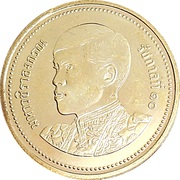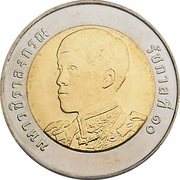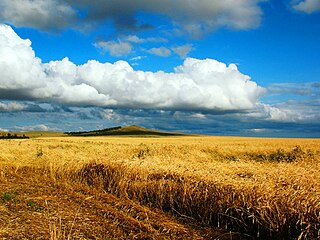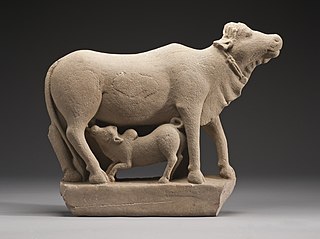
Agriculture in Thailand is highly competitive, diversified and specialized and its exports are very successful internationally. Rice is the country's most important crop, with some 60 percent of Thailand's 13 million farmers growing it on almost half of Thailand's cultivated land. Thailand is a major exporter in the world rice market. Rice exports in 2014 amounted to 1.3 percent of GDP. Agricultural production as a whole accounts for an estimated 9–10.5 percent of Thai GDP. Forty percent of the population work in agriculture-related jobs. The farmland they work was valued at US$2,945/rai in 2013. Most Thai farmers own fewer than eight ha (50 rai) of land.

In Thailand, the two-baht coin is the coin which is worth 2 baht or 200 satang. The new 2-baht coin design features H.M. King Bhumibol Adulyadej, the Great on the obverse, like all other Thai legal tender coins presently in circulation. The reverse design depicts the Golden Mountain at Wat Saket Ratcha Wora Maha Wihan in Bangkok.

The bi-metallic Thailand ten-baht coin is a denomination coin of the Thai baht, the currency unit of Thailand.

Agriculture in Kazakhstan remains a small scale sector of Kazakhstan's economy. Agriculture's contribution to the GDP is under 10% - it was recorded as 6.7%, and as occupying only 20% of labor. At the same time, more than 70% of its land is occupied in crops and animal husbandry. Compared to North America, a relatively small percentage of land is used for crops, with the percentage being higher in the north of the country. 70% of the agricultural land is permanent pastureland.

Camel milk is milk from female camels. It has supported nomad and pastoral cultures since the domestication of camels millennia ago. Herders may for periods survive solely on the milk when taking the camels on long distances to graze in desert and arid environments, especially in parts of the Middle East, North Africa and the Horn of Africa. The camel dairy farming industry has grown in Australia and the United States, as an environmentally friendly alternative to cow dairy farming using a species well-adapted to arid regions.

Agriculture in South Korea is a sector of the economy of South Korea. Korean agriculture is the basic industry of the Korean economy, consisting of farming, animal husbandry, forestry and fishing. At the time of its founding, Korea was a typical agricultural country, with more than 80% of the population engaged in agricultural production. After land reform under the Lee Seung-man administration, economic revitalization under the Park Chung-hee military government and the wave of world trade liberalization that began in the 1980s, Korean agriculture has undergone dramatic changes. Through the Green Revolution, Korea became self-sufficient in rice, the staple food, in 1978, and in 1996, Korea became the first Asian country after Japan to mechanize its agriculture with fine-grained cultivation. The development of Korean agriculture has also led to the development of agriculture-related industries such as fertilizer, agricultural machinery and seed.

Many farmers in India depend on animal husbandry for their livelihood. In addition to supplying milk, meat, eggs, wool, their castings (dung) and hides, animals, mainly bullocks, are the major source of power for both farmers and dairies. Thus, animal husbandry plays an important role in the rural economy. The gross value of output from this sector was 8,123 billion Rupees in FY 2015–16.

In New Zealand, agriculture is the largest sector of the tradable economy. The country exported NZ$46.4 billion worth of agricultural products in the 12 months to June 2019, 79.6% of the country's total exported goods. The agriculture, forestry and fisheries sector directly contributed $12.653 billion of the national GDP in the 12 months to September 2020, and employed 143,000 people, 5.9% of New Zealand's workforce, as of the 2018 census.

The Ministry of Interior of the Kingdom of Thailand is a cabinet-level department in the Government of Thailand. The ministry has wide ranging responsibilities. It is responsible for local administration, internal security, citizenship, disaster management, road safety, land management, issuance of national identity cards, and public works. The ministry is responsible for appointing the 76 governors of the Provinces of Thailand. The Minister of Interior is the head of the ministry. He is appointed by the King of Thailand on the recommendation of the prime minister. Since 30 August 2014, the head of the ministry has been retired General Anupong Paochinda. He is aided by two deputy ministers. The FY2019 budget of the ministry is 371,802 million baht.

The Ministry of Agriculture and Cooperatives is a cabinet ministry in the government of Thailand. The ministry is one of the oldest ministries in the government, tracing its existence to the 14th century. The ministry is responsible for the administration of agricultural policies, forestry, water resources, irrigation, promotion and development of farmers and cooperative systems, including agricultural manufacturing and products. As Thailand is an agricultural country with a strong agrarian tradition, the ministry is one of the most important departments in the government. The ministry is headed by a Minister of Agriculture and Cooperatives. As of September 2019, the Minister of Agriculture and Cooperatives is Dr Chalermchai Sreeon assisted by three deputy ministers.

Rice production in Thailand represents a significant portion of the Thai economy and labor force. In 2017, the value of all Thai rice traded was 174.5 billion baht, about 12.9% of all farm production. Of the 40% of Thais who work in agriculture, 16 million of them are rice farmers by one estimate.

Dairy farming in New Zealand began during the early days of colonisation by Europeans. The New Zealand dairy industry is based almost exclusively on cattle, with a population of 4.92 million milking cows in the 2019-20 season. The income from dairy farming is now a major part of the New Zealand economy, becoming an NZ$13.4 billion industry by 2017.

The Bureau of the Royal Household (BRH) is an agency of the monarchy of Thailand. In addition to a range of administrative and ceremonial responsibilities, the bureau also serves as a conduit for royal philanthropy.

Aavin is a State Government Cooperative under the ownership of Tamil Nadu Cooperative Milk Producers Federation Limited (TNCMPFL), Ministry of Cooperation, Government of Tamil Nadu and the trademark of TNCMPFL. Aavin procures milk, processes it and sells milk and milk products to consumers.
The Doi Kham Company was founded in 1994 by the Crown Property Bureau at the request of King Bhumibol Adulyadej to set up a business to buy products from royal projects and farmers at fair prices and sell quality products to the Thai population.

The Thailand Royal Rainmaking Project was initiated in November 1955 by King Bhumibol Adulyadej. Thai farmers repeatedly suffered the effects of drought. The king resolved to do something about it and proposed a solution to the dearth of rain: artificial rainmaking, or cloud seeding. The program is run by the Department of Royal Rainmaking and Agricultural Aviation.

Thailand's Department of Fisheries, part of the Ministry of Agriculture and Cooperatives, is responsible for the promotion of the Thai fishing industry while ensuring the sustainability of aquaculture and capture fisheries. It conducts, compiles, and disseminates research and technologies to further those aims. Its mission statement makes no mention of illegal, unreported and unregulated fishing (IUU), the responsibility of other agencies such as the Ministry of Labour.
The Fishing industry in Thailand, in accordance with usage by The World Bank, the UN's Food and Agriculture Organization (FAO) and other multinational bodies, refers to and encompasses recreational fishing, aquaculture, and wild fisheries both onshore and offshore.

Dairy plays a significant part in numerous aspects of Indian society, including cuisine, religion, culture, and the economy.


















